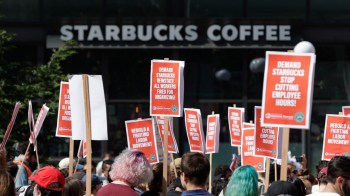
How song makes the union strong

Union organizer and balladeer Joe Hill, a member of the Industrial Workers of the World, once said, “A pamphlet, no matter how good, is never read more than once, but a song is learned by heart and repeated over and over.”
It also helped that many union songs sounded familiar, even when they were brand new. Most songs were written to the tune of religious hymns, contemporary popular tunes and folk standards. And unions, including the Industrial Workers of the World, whose members were known as Wobblies, would publish and distribute songbooks with tunes specific to their members and their industries.
Many songs were “based on popular religious songs. One of the reasons was that the Wobblies would organize on street corners,” said Saul Schniderman, chair of the Labor Heritage Foundation and a former union president at the Library of Congress.
“Right across the street was the Salvation Army, which was a singing Christian group. So they borrowed lots of their songs and wrote parodies.”
The famous anthem “Solidarity Forever,” for example, used the melody from the marching song “John Brown’s Body,” which became popular during the American Civil War.
“The advantage of using songs that people already know, you don’t have to teach them,” said Jeff Place, curator and senior archivist for Smithsonian Folkways Recordings, a record label in Washington, D.C. Smithsonian’s archive includes many recordings of labor and union songs.
When union activist Florence Reece, a Harlan County, Kentucky, resident, wrote “Which Side Are You On?” she borrowed the melody from “Lay the Lily Low,” a ballad about a woman who disguises herself as a man and rescues her lover after he goes to war. The same melody was also used in a Baptist hymn.
Reece wrote the song in 1931 after J.H. Blair, the county sheriff at the time, hired men to arrest her husband, Sam, a coal miner and union supporter. They arrived at the Reeces’ home, and when they couldn’t find Sam, they ransacked the place and threatened Florence and her children.
Forty years later, Reece performed the same song for miners and their families during the 1973 Brookside strike, as captured in the documentary “Harlan County U.S.A.” Most of the people in the room knew the lyrics by heart.
Come all of you poor workers / Good news to you I’ll tell
Of how that good old union / Has come in here to dwell
Which side are you on?If you go to Harlan County / There is no neutral there
You’ll either be a union man / Or a thug for J.H. Blair
Which side are you on?
“Which Side Are You On?” grew in popularity outside of Harlan County after the Almanac Singers, a group that included folk singer Pete Seeger, recorded the song for their 1941 album “Talking Union.” And there were many other songs from coal country, including those written by Harlan’s own Nimrod Workman, Aunt Molly Jackson and Sarah Ogan Gunning that were well-known outside of southeastern Kentucky, especially amongst other unions.
Schniderman of the Labor Heritage Foundation attributes the songs’ appeal to the dangers that miners faced on the job, the tragedies they endured and the extreme hostility their unions encountered when fighting for workers’ rights.
“The number of strikes that coal miners have had to wage, and the length of these strikes, and the suffering that they had to overcome, inspired people to write and sing songs for support and for solace,” Schniderman said.
When Reece wrote “Which Side Are You On?” the Harlan County Coal Operators’ Association had reduced employees’ already low wages by 10%. Many children of mine workers were starving to death.
“Harlan County U.S.A.” opens with a montage of coal workers in the mines, overlaid with Nimrod Workman’s voice singing “42 Years,” about the toll the mines had taken on his health.
Workman sings:
My bones, they did ache me / My kneecaps got bad
Down on a hard rock / On a set of knee pads
The motors were shifting / Got sand in my hair
Both lungs were broke / Down from breathing bad air.
Coal mining remains a dangerous profession. More than 100,000 U.S. miners died in mining accidents between 1900 and 1970 alone. Millions more suffered nonfatal injuries and 1 in 5 coal workers who’ve worked 25 years or more in the industry have developed black lung disease.
“Rank-and-file union members who engage in strikes and protests … they really need nourishment, and oftentimes spiritual nourishment,” Schniderman said. “The role of labor songs has been to inspire and to build solidarity with the general public and to unite workers in a cause.”
Schniderman added: “There’s no way an employer can stop anyone from singing.”
Want to listen to more tunes?
Independent labor reporter Kim Kelly curated a playlist of labor and union songs for Smithsonian Folkways. And in 2006, a CD compilation of songs featured in “Harlan County U.S.A.” was published. Here is a Spotify link to that album.
How to watch along with us
“Harlan County U.S.A.” is available to stream on Max and the Criterion Channel, with a subscription. It also may be available to borrow at your local library.
There’s a lot happening in the world. Through it all, Marketplace is here for you.
You rely on Marketplace to break down the world’s events and tell you how it affects you in a fact-based, approachable way. We rely on your financial support to keep making that possible.
Your donation today powers the independent journalism that you rely on. For just $5/month, you can help sustain Marketplace so we can keep reporting on the things that matter to you.

















